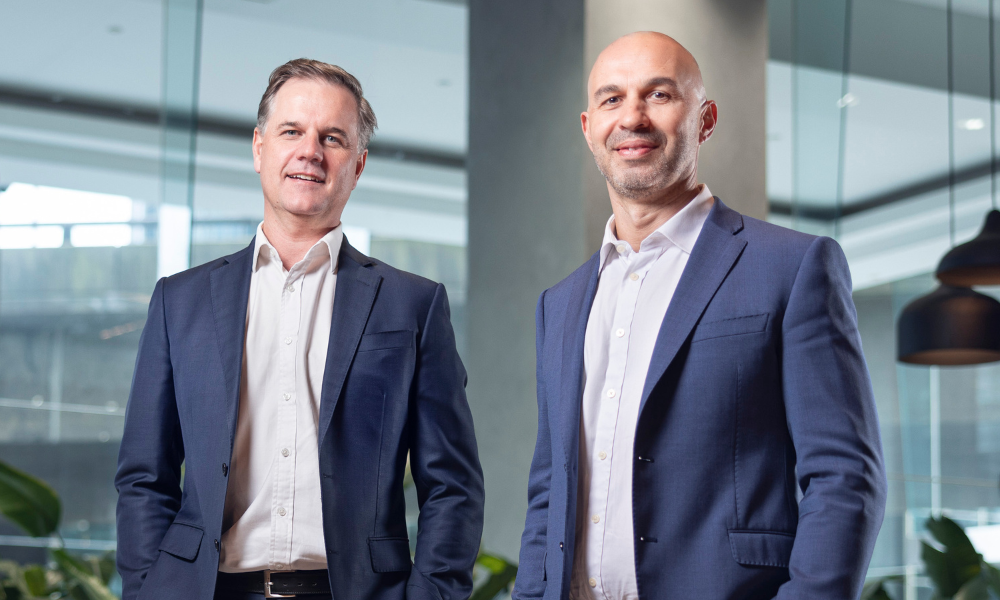Specialist lending plays a big part in settlements

Resimac has declared a half-year statutory net profit after tax of $38.9 million, down 27% on the first half of 2022.
In its half-year results for the six months ending December 31, Resimac Group (which includes operations in Australia and New Zealand), confirmed home loan settlements of $2.4 billion, down 31% compared to the first half of 2022, and 14% below the second half.
Asset finance settlements were $210m, down from $227m in the second half of 2022, but up 17% compared to the same time last year.
In Resimac’s half-yearly report, home loan assets under management were $14.7bn, down 0.68% from $14.6bn compared to the same time last year.
The portion of settlements via the broker channel grew from the traditional 85%, to 90%, Resimac confirmed.
Resimac CEO Scott McWilliam (pictured above left) said given the anticipated impacts of inflation and rising interest rates, the results were broadly in line with expectations.
In a challenging market, Resimac Group continued to originate high quality home loan and asset finance loans, he said.
“To counter fierce price competition from the banks, we made a strategic decision to focus on our specialist portfolio,” McWilliam said.
“I’m pleased to announce we settled $2.4 billion of home loans in this half – two-thirds of which came from specialist loans, whilst maintaining credit risk standards. The average LVR at origination of these specialist loans was 71%.”
McWilliam said he was also pleased that the non-bank lender’s net interest margin (NIM) increased four basis points compared to the second half of 2022, which he said was driven by repricing in line with the RBA tightening cycle.
“Our portfolio continues to perform well, with loan impairments at very low levels. Early stage arrears have increased, however our conservative approach to provisioning at 30 June 2022 ensures the Group has sufficient coverage for the system stress that potentially lies ahead,” McWilliam said.
Capital markets continued to show a strong appetite for Resimac residential mortgage-backed securities, McWilliam said, noting the Group had issued $1.2bn in RMBS transactions, though at higher margins than observed in FY22.
Near prime settlements remain steady
Resimac CFO Jason Azzopardi (pictured above right) told MPA that near prime lending was little changed from the second half of 2022.
“In Australia, near prime and specialist settlements were broadly in line compared to previous half,” Azzopardi said.
Funding costs were increasing off extremely low levels, to a more normalised level, Azzopardi said.
The competitive market was largely driven by aggressive bank pricing, which were able to access cheap funding stimulus, notably the term funding facility, he said.
“Opportunities for near prime business continue. Ultimately the size of the opportunity is dictated by system activity increasing, which will occur when the current uncertainty is removed,” Azzopardi said.
Resimac half-year results snapshot (to December 31, 2022)
- Statutory net profit after tax: $38.9m
- Normalised net profit after tax: $37.5m
- Normalised net profit after tax (excluding FV gains/losses on derivatives): $40.7m
- Home loan settlements: $2.4bn
- Asset finance settlements: $210m
- Interim dividend per share: 4c (unchanged from 2H22, 1H22)
Outlook for the second half year
With interest rate rises forecast to continue in 2023, together with ongoing inflation pressures, McWilliam said he was “pragmatic” about the Group’s outlook over the next six to 12 months.
While economic headwinds are likely to continue throughout the 2023 financial year, McWilliam said he was optimistic that the current economic cycle would turn.
The non-bank lender would continue to focus on where it sees the greatest opportunities in the short-term: mainly its home loan specialist and asset finance lending solutions, he said.
“Our strategy has always been, and will continue to be, on creating niche products for under-serviced markets overlooked by the major lenders,” McWilliam said.
He confirmed that a major digital transformation project had been completed, resulting in the business moving to a new loan originations and core banking platform.
“The new system lays a solid foundation for immediate and significant future enhancements to brokers and customers, which will vastly improve their experience of doing business with us in the future,” McWilliam said.



